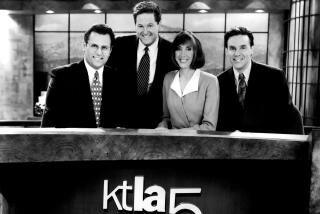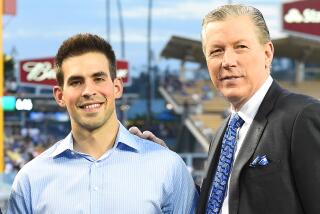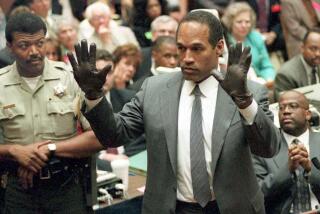Courting the Right Image in TV News
- Share via
The salesmen are winning, the result being that many viewers select a local newscast to watch for the wrong reasons. Affirmation came in the ratings sweeps for November.
That was the month that KABC-TV Channel 7 retook the ratings lead from once-dominant KNBC Channel 4 at 4 p.m. in estimates by the A. C. Nielsen Co., adding a whopping 90,000 households to its news audience for that hour over what it had had in November, 1989.
It was also the month that Christine Lund rejoined Channel 7 as a co-anchor on the 4 p.m. newscast.
The unmistakable conclusion:
Lund’s “fans,” as Channel 7 news director Roger Bell has labeled her followers, made the difference.
True, the 4 p.m. newscast undoubtedly benefited some by improved November ratings for its lead-in, “The Oprah Winfrey Show,” and KABC’s 5 p.m. newscast itself eked out a narrow win over its Channel 4 competition. However, the timing of Lund’s ballyhooed return--at the start of the sweeps--is compelling evidence that she was the major factor in Channel 7’s success.
Without her, Channel 7 was behind. With her, it’s ahead.
It’s hardly news that anchors are essentially come-ons, drawing viewers to newscasts the way mannequins attract window shoppers. That accounts for the bloated salaries they receive for contributing little more than their faces, personalities and ability to communicate live during breaking stories without swallowing their tongues.
Rarely, however, has the statistical evidence of their marquee value been as clear cut as in the case of Lund, who was off the air four years and hotly wooed by other stations before resurfacing on Channel 7 beside Harold Greene.
I admit it: There just isn’t anyone on the air--anywhere--more pleasant than Lund. She’s a regular mommy, milk and cookies, an easy oldie, a saint, a platinum Mother Teresa. As in her former days as an anchor, she radiates niceness and goodness. Her face reads honest and trustworthy. Despite her glamorous good looks, she projects no trace of ego. She’s Everywoman--your sister, mother, aunt, wife and girlfriend rolled into one. You’d want her for a pal. You’d want her for a neighbor. You’d want her for a pin-up.
And now it’s obvious that gobs of news viewers still just want her, period!
But trust me: Although Lund can do anchor chitchat and make you feel warm and cozy, when it comes to news, KABC’s 4 p.m. program is no better with Lund than it was without her. Her reporting days are far behind her. Like most anchors, she’s a glossy ornament, a host, presenter and news-reader who has no input or role in gathering or reporting news.
So think about it. Although some Los Angeles viewers surely do use other criteria, thousands and thousands more are watching a newscast at a given moment not because of the news product but because of the news package.
Or to put it another way, the package is the product.
Not all anchors function solely as mannequins.
For example, no one here was more passionate about news coverage than Nick Clooney, the former KNBC Channel 4 anchor who angered management by constantly lobbying for improvement when he was at the station a few years ago.
Meanwhile, KCAL Channel 9 anchor David Jackson has shown his reporting skills in the Persian Gulf region, and KCBS-TV Channel 2 has its relatively new 6 p.m. anchor Michael Tuck delivering commentaries at 11 p.m.
Ah, yes, Gilbraltar-jawed, basso-voiced Tuck, the big boomer himself, he of the slurred, fast-forwarded signature:
“I’mMichaelTuckandthat’smyperspective.”
Why the show? Why does Tuck remove his jacket, loosen his tie and sit in his shirt-sleeves to tape his 11 p.m. segment? Are we to infer that he’s Ted Baxter at 6 p.m., Jimmy Breslin at 11 p.m.?
The presence of the lecturing Tuck at 11 p.m., having gained insight into Los Angeles apparently from his watching post in San Diego, is a vivid reminder of the depressed state of commentary on Los Angeles stations.
On Channel 7, the only other station in town offering regular commentary, Bruce Herschensohn focuses almost exclusively on national and global issues, while his liberal counterpart, attorney Gloria Allred, is far less incisive than opinionated. Her only advantage over her extremely able predecessor, Bill Press, is that she’s a woman in a field desperately needing greater female representation.
At Channel 2, you have to like it that Tuck shoots to kill--you’re never in doubt where he stands--but not that his shots come mostly from the hip. There’s a shrillness and rushed quality to his 90-second commentaries, almost as if he dashed them off on the way to the TelePrompTer.
The comparison with Bill Stout--the late, much-missed Channel 2 commentator who had deep, gnarly roots in the community and who valued journalism more than performance--is inescapable.
On the other hand, Tuck has a better voice.
The voice that resonated loudest in many TV newsrooms during the November sweeps was the shrieking, grating voice of hucksterism.
No sweeps month in recent history contained as many news/entertainment cross-promotions as this one. Predictably, Channel 7 once again dragged Oprah Winfrey into its 4 p.m. newscast for a series of compelling chats about the weight she’s gained.
However, no station cross-promoted with more fervor than Channel 2, whether following “Geraldo” with a scintillating 5 p.m. news interview with Geraldo Rivera on his sexual problems, or the nightly promotion of CBS entertainment programs on the 11 p.m. news.
Typical was Steve Kmetko’s “exclusive” interview” with “Murphy Brown” star Candice Bergen on a Monday night, coincidentally the same night that “Murphy Brown” aired. Gee, what a coup for Kmetko.
News at 11, television’s landfill for ethics.
The recent announcement that Channel 4 was firing reporter Wil Spens was greeted by mixed reactions in some quarters.
On the one hand, Spens was absolutely the funniest guy in TV news, no contest. Not even Channel 4 weather comic Fritz Coleman came close.
Nicknamed “Crime Dog” by some of his colleagues, Spens was the station’s crime reporter at 11 p.m., theatrically roaming the city’s dark streets with his camera crew, invading neighborhoods to deliver his melodramatic “live” reports with a grimace.
Spens’ act was motion. The red light would turn on, and simultaneously so would he, immediately surging into action, whether knocking on a door where a crime had occurred the night before (“No one home!”), or just walking very fast, always walking. Where was he walking? Nowhere, but that didn’t matter, for walking implied action and excitement, the very qualities that Channel 4 hoped would rivet viewers to its 11 p.m. newscast.
On the other hand, as much of a joke as Spens was, he was merely doing the bidding of his bosses while reflecting a local news obsession with form over content.
In this case, the show-biz form--hardly exclusive to Channel 4--is “live” TV, the “live” tag on a story meant to convey immediacy, even when, as in most instances, none exists.
Spens’ mandate was to deliver a “live” story for each 11 p.m. newscast. Most times that meant sandwiching a tape package between a live intro and close. Often it entailed reporting “live” at 11 p.m. about something that occurred perhaps 16 hours earlier.
Even without Spens, this deceptive exercise will continue on Channel 4 just as it does on other stations, even though local news is usually never deader than when it goes “live.” Anyway. . . .
I’mHowardRosenbergandthat’smyperspective.
More to Read
The complete guide to home viewing
Get Screen Gab for everything about the TV shows and streaming movies everyone’s talking about.
You may occasionally receive promotional content from the Los Angeles Times.






